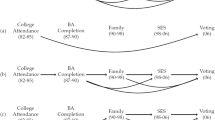Abstract
Using state senate data from 1984 through the beginning of 2002, this paper finds that campaign donation regulations clearly reduce the competitiveness in political races. This is reflected in several dimensions. Conservative estimates indicate that different donation limits are associated with anywhere from a 4 to over a 23 percentage point increase in win margins. The regulations increase the probability that only one candidate will run for office. And they increase the probability that incumbents win re-election. Campaign finance regulations also tend to reduce the number of candidates who run for office by an average of about 20 percent.
Similar content being viewed by others
References
Bauer, R.F. (2002). Soft Money Hard Law: A Guide to the New Campaign Finance, Perkins Coie LLP: Washington, D.C.
Bronars, S.G., & John R. Lott, Jr. (1997). Do campaign donations alter how a politician votes? Coauthored with Steve Bronars. Journal of Law and Economics, 40(2), 317–350.
Bruce, B. (1988). An analysis of congressional voting on legislation limiting congressional campaign expenditures. Journal of Political Economy, 96(5), 1005–1021.
Bruce, B. (1991). The influence of ideology on congressional voting. Economic Inquiry, 29(3), 416–428.
Coate, S. (2001). Political competition with campaign contributions and informative advertising. NBER Working Paper.
Coate, S., & Morris, S. (1995). On the form of transfers to special interests. Journal of Political Economy, 103, 1210–1235.
Crain, W.M., & Tollison, R. (1995). Campaign expenditures and political competition. Journal of Law and Economics, 19, 177–188.
Crain, W.M., & Tollison, R. (1977). Attenuated property rights and the market for governors. Journal of Law and Economics, 20, 205–212.
Crain, W.M., Donald R., Leavens, & Tollison, R. (1986). Final Voting in Legislatures American Economic Review, 76, 833–841.
Crain, W.M., & Oakley, L.K. (1995). The politics of infrastructure. Journal of Law and Economics, 38, 1–18.
Daniel, K., & John, R.L. Jr. (1997). Term limits and electoral competitiveness: Evidence from California's state legislative races. Public Choice, 90, 165–184.
Dick, A.R., & John R.L. Jr. (1993). Reconciling voters' behavior with legislative term limits. Journal of Public Economics, 50(1), 1–14.
Grier, K. (1989). Campaign spending and senate elections, 1978–1984. Public Choice, 63, 201–220.
Hersch, P.L., & McDougall, G.S. (1994). Campaign war chests as a barrier to entry in congressional races. Economic Inquiry, 630–641.
Hoggan, R.E. (2000). The costs of representation in state legislatures: Explaining variations in campaign spending. Social Science Quarterly, 941–956.
Jacobson, G. (1975). The impact of broadcast campaigning on electoral outcomes. Journal of Politics, 769–793.
Jacobson, G. (1978). The effects of campaign spending in congressional elections. American Political Science Review, 469–491.
Jacobson, G. (1980). Money in Congressional Elections, New Haven, CT.: Yale University Press.
Kau, J.B., Keenan, D., & Rubin, P.H. (1982). A general equilibrium model of congressional voting. Quarterly Journal of Economics, 97, 271–293.
Kenny, L., & Francis, W.L. (2000). Up the Political Ladder: Career Paths in U.S. Politics, Sage: Thousand Oaks CA.
Knack, S. (1995). Does ‘Motor Voter' work?: Evidence from the state-Level data. Journal of Politics, 796–811.
Knack, S. (1999). Drivers wanted: Motor voter and the election of 1996. Political Science & Politics.
Lott, J.R., Jr. (1987a). The effect of nontransferable property rights on the efficiency of political markets, some evidence. Journal of Public Economics, 32, 231–246.
Lott, J.R., Jr. (1989). Explaining challengers' campaign expenditures: The importance of sunk nontransferable brand name. Public Finance Quarterly, 17(1), 108–118.
Lott, J.R., Jr. (1990). An explanation for public provision of schooling: The importance of indoctrination. Journal of Law and Economics, 33, 199–232.
Lott, J.R., Jr., (2000). A simple explanation for why campaign donations are increasing: The government is getting bigger. Journal of Law and Economics, 42(2), 359–393.
Milyo, J. (1997). The economics of campaign finance: FECA and the puzzle of the not very greedy grandfathers. Public Choice, 93, 245–270.
Milyo, J., & Groseclose, T. (1999). The electoral effects of incumbent wealth. Journal of Law and Economics, 699–722.
Ornstein, N.J., Mann, T.E., & Malbin, M.J. (2002). Vital Statistics on Congress: 2001–2002, The American Enterprise Press: Washington, D.C.
Peltzman, S. (1976). Towards a more general theory of regulation. Journal of Law and Economics, 19(2), 211–240.
Peltzman, S. (1980). The growth of government. Journal of Law and Economics, 23(2), 209–287.
Poole, K.T., & Romer, T. (1993). Ideology, ‘Shirking,’ and representation. Public Choice, 97, 185–196.
Public, C. (2002). Clean money, clean elections comparisons. Public Campaign: Washington, DC.
Reed, W.R., & Schansberg, E. (1992). The behavior of congressional tenure over time: 1953–1991. Public Choice, 73, 183–203.
Reed, W.R., & Schansberg, D.E. (1994). An analysis of congressional term limits. Economic Inquiry, 32, 79–91.
Reed, W.R., & Schansberg, D.E. (1995). The house under term limits: What would it look like? Social Science Quarterly, 76, 699–716.
Snyder, James M., Jr. (1990). Campaign contributions as investments: The U.S. House of Representatives, 1980–1986. Journal of Political Economy, 98(6), 1195–1227.
Snyder, James M., Jr. (1992). Long-term investing in politicians; or, give early, give often. Journal of Law and Economics, 35, 15–44.
Stratmann, T. (1991). What do campaign contributions buy?: Deciphering causal effects of money and votes. Southern Economic Journal, 57, 606–620.
Stratmann, T. (1992). Are contributors rational?: Untangling strategies of political action committees. Journal of Political Economy, 100, 647–664.
Stratmann, T., & Aparaicio-Castillo, F.J. (2002). Competition policy for elections: Do campaign contribution limits matter. George Mason University Working Paper.
Author information
Authors and Affiliations
Corresponding author
Rights and permissions
About this article
Cite this article
Lott, J.R. Campaign finance reform and electoral competition. Public Choice 129, 263–300 (2006). https://doi.org/10.1007/s11127-006-9028-x
Received:
Accepted:
Published:
Issue Date:
DOI: https://doi.org/10.1007/s11127-006-9028-x




